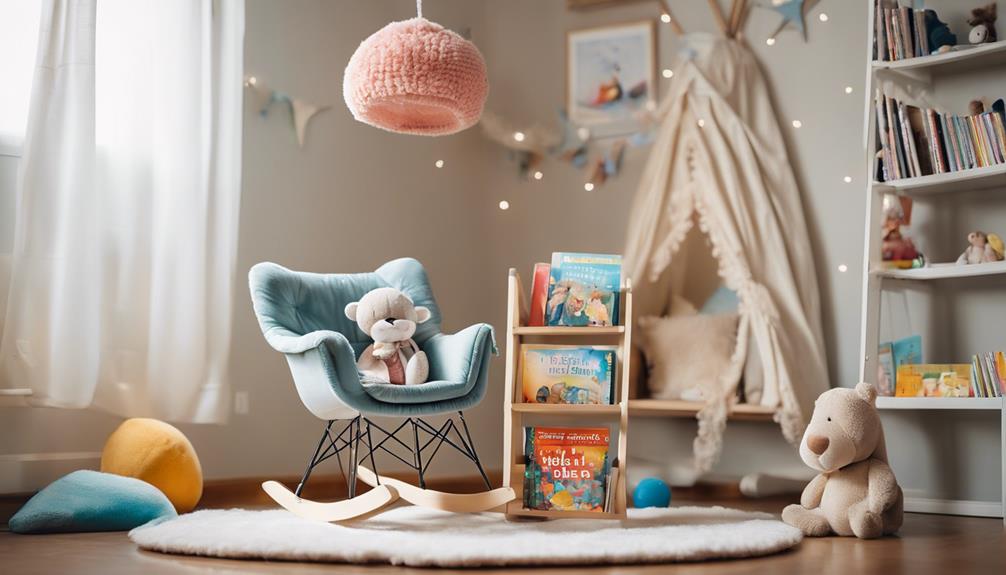During storytime with your baby, it is important to choose books that match their interests and incorporate interactive board books with textures. By including touch and feel or lift-the-flap books, you can provide sensory experiences that will enhance the reading session. Adding music, changing voices, and incorporating movements can make storytelling more engaging for your little one. It is also beneficial to establish a consistent reading schedule during calm times and be attentive to signs of restlessness. Varying your voice, using expressive reading with facial expressions, and encouraging participation through discussions can make storytime more interactive. Creating cozy reading nooks with cushions and exploring different themes outdoors can also make the experience more enjoyable. To further enhance engagement, consider unique reading locations and post-reading activities. For more tips on interactive storytime, check out the suggestions provided.
Key Takeaways
- Choose books matching child's interests for engagement.
- Use interactive storytelling techniques like touch and feel books.
- Maintain a consistent reading schedule during alert times.
- Incorporate interactive elements and discussions post-reading.
- Create cozy reading environments with props for a captivating storytime.
Choosing Books Together
When selecting books with your baby, involve them by offering choices between two options to boost engagement. Reading books with your child not only helps them develop language skills but also creates a special bonding experience.
Board books are great for little ones as they're durable and easy for babies to handle independently. These books often have simple, high-contrast images or textures that capture your baby's attention and encourage interaction.
When you help your child choose books that match their interests, such as animals or colors, you're encouraging their curiosity and engagement with the story. Interactive board books with features like flaps, mirrors, or sounds can further enhance sensory experiences during storytime.
Consider Attention Span

To keep your baby engaged during storytime, adjusting activities to match their short attention span is important. When reading to children, attention span plays a significant role in maintaining their interest.
Here are some tips to help you keep your child engaged during storytime:
- Choose interactive books: Opt for books with touch-and-feel elements or lift-the-flap features to keep your baby engaged.
- Incorporate simple songs: Singing nursery rhymes or songs related to the story can help sustain your child's interest.
- Rotate activities: Switch between reading, singing, and interactive play to cater to your baby's short attention span.
- Watch for cues: Be mindful of signs of restlessness or disinterest, and be ready to adjust the activity or switch to a different book or game.
Reading Schedule Tips
Establish a consistent reading schedule by incorporating it into your daily routine for peak engagement during storytime with your baby.
By choosing calm and alert times for reading sessions, you can maximize your child's focus and enjoyment. Linking reading with relaxation and pleasure creates a positive experience, making it more likely for your baby to look forward to reading time.
Creating a cozy and comfortable reading environment further enhances the atmosphere for storytime. Setting aside dedicated and uninterrupted time for reading books helps foster a love for reading in your little one.
Consistency in your reading schedule is key to building a routine that your child will come to anticipate and enjoy. Remember, the goal is to make reading a cherished part of your daily interactions, creating lasting memories and instilling a lifelong love for books in your child.
Engaging Activities

To make storytime engaging for your baby, try using interactive storytelling techniques that involve funny voices and movements. Incorporate touch and feel or lift-the-flap books to stimulate their senses and curiosity.
Don't forget to add music and movement activities to make the storytelling experience dynamic and fun for your little one!
Interactive Storytelling Techniques
Enhance your storytelling sessions by using different voices, expressions, facial gestures, and varied tones to keep children engaged and promote comprehension.
Interactive storytelling techniques can make storytime more exciting and educational. Here are some tips to help you create an immersive storytelling experience for your little one:
- Read aloud with enthusiasm: Bring the story to life by using animated voices and lively expressions.
- Encourage participation: Ask open-ended questions to involve children in the storytelling process.
- Use gestures and facial expressions: Emphasize key points in the story with appropriate gestures and facial cues.
- Vary tones for characters: Differentiate between characters or scenes by changing your tone and pitch, making the story more engaging and easier to follow.
Sensory Exploration Activities
Engage your baby's senses through interactive and stimulating activities that promote sensory exploration. Sensory exploration activities involve touch, sight, sound, and movement, providing essential stimulation for your baby's development. Incorporating books with different textures, musical toys, and soft objects into playtime can enhance sensory experiences and support early literacy skills. These activities not only entertain but also help build nerve connections, improve cognitive abilities, and aid in language development. Through sensory play, babies learn about their surroundings, develop fine motor skills, and boost brain development. Additionally, engaging in sensory exploration can assist in emotional regulation and overall sensory processing. Encourage pretend play with picture books that incorporate sensory elements, creating a fun and educational environment for your baby to explore. Below is a table showcasing some sensory exploration activities that can benefit your baby's development:
| Sensory Activity | Benefits |
|---|---|
| Textured Books | Enhances tactile senses and early literacy |
| Musical Toys | Stimulates auditory skills |
| Soft Objects | Promotes fine motor skills and sensory play |
Music and Movement Integration
Incorporating music and movement into storytime creates a dynamic and interactive experience for engaging babies in a multisensory adventure.
Here are some tips to make the most out of music and movement integration during storytime:
- Use Songs, Rhymes, and Fingerplays: Incorporating these elements enhances the storytelling session and encourages active participation from children.
- Promote Development of Motor Skills: Music and movement activities help in developing children's motor skills, coordination, and sense of rhythm.
- Create an Interactive Environment: Integrate music and dance to keep babies entertained and engaged throughout the storytime session.
- Enhance Cognitive Skills: Research shows that music and movement activities can stimulate brain development and support language acquisition in babies.
Reading Aloud Techniques

To make storytime more engaging for babies, utilize different voices and expressions while reading aloud. By varying your tone, pitch, and speed, you can bring the story to life and capture your little one's attention. Incorporating expressive reading techniques helps in promoting language development and emotional connection with the narrative. Additionally, using interactive elements such as asking questions or encouraging responses can keep babies engaged throughout the storytelling session.
To further illustrate the importance of reading aloud techniques, consider the following table:
| Reading Aloud Techniques | Description |
|---|---|
| Vary Voices | Use different voices for various characters. |
| Expressive Reading | Employ facial expressions and gestures. |
| Tone and Pitch Variation | Differentiate characters with tone and pitch. |
| Interactive Elements | Include questions and encourage responses. |
| Emotional Connection | Utilize expressive reading for a deeper bond. |
Creative Story Time Ideas

Enhance your baby's storytelling experience by introducing creative elements such as props, sensory bins, and music activities. These ideas will make storytime engaging and fun:
- Props: Incorporate puppets or stuffed animals to bring characters to life and make the story more interactive.
- Sensory Bins: Use themed sensory bins or tactile materials related to the story to allow your baby to touch and feel while listening, creating a hands-on experience.
- Music: Integrate music and movement activities that complement the story, such as singing songs or playing instruments to add a dynamic element to the storytelling.
- Interactive Storytelling: Make the storytime interactive by encouraging your baby to participate through gestures, responses, or simple actions that relate to the plot, enhancing their understanding and enjoyment of the story.
Unique Reading Locations

When it comes to reading to a baby, consider exploring unique locations to make storytime engaging and fun.
Outdoor story corners in parks or gardens can provide a sensory-rich experience, while bath time tales can create a soothing and multi-sensory environment for your little one.
Outdoor Story Corners
Consider transforming your outdoor space into an enchanting outdoor story corner for a unique reading experience with your baby. Outdoor story corners offer a wonderful opportunity to engage your child in storytime while enjoying the beauty of nature.
Here are some tips to make the most of your outdoor reading space:
- Encourage your child: Create a cozy reading nook with cushions and blankets to make your baby feel comfortable and enthusiastic to explore children's books.
- Act out the story: Use props and costumes to bring the story to life, making it an interactive and memorable experience for your little one.
- Learn new: Explore different themes and genres to introduce your baby to a variety of stories and spark their curiosity and imagination.
- Engage with nature: Incorporate natural elements like plants, rocks, or a small garden into your outdoor story corner to enhance sensory exploration and foster a love for both reading and the outdoors.
Bath Time Tales
Transforming bath time into a storytelling adventure can provide a unique and enjoyable reading experience for both you and your baby. Bath time tales can help kids wind down and relax, making it a perfect opportunity to incorporate reading into your daily routine.
The soothing environment of bath time enhances relaxation and engagement during story sessions, creating a calming bedtime routine for your little one. Choosing books related to the story of water, bubbles, or bath time routines can make reading more relatable and enjoyable for your baby.
Reading during bath time not only entertains but also promotes language development and strengthens the bond between you and your child. The combination of warm water, gentle splashes, and a good story can create lasting memories and positive associations with reading.
Post-Reading Engagement

Enhance your baby's comprehension and interaction by engaging in discussions and activities after reading a story together. Here are some tips to make the most out of post-reading engagement:
- Discuss Characters and Events:
Talk about the story's characters or events to reinforce what your baby has just heard.
- Encourage Participation:
Prompt your baby to point to pictures, make sounds, or mimic gestures from the story for interactive engagement.
- Extend with Activities:
Incorporate related activities like drawing, coloring, or acting out scenes from the book to prolong the storytime experience.
- Revisit Themes and Morals:
Revisit the story's themes or moral lessons to reinforce learning and encourage reflection on the message conveyed.
Frequently Asked Questions
How Do You Make Story Time More Engaging?
To make story time more engaging, you can bring characters to life with funny voices and movements. Ask open-ended questions to spark conversation. Let the child take the lead and choose beautiful books with interactive elements like singing, dancing, and colorful illustrations.
How Do You Introduce Reading to a Baby?
To introduce reading to a baby, start with high-contrast black and white books. Use sturdy board books for exploring. Begin reading early to foster language development. Make it engaging with voices and interactive elements.
How Do You Engage Children When Reading a Story?
To engage children when reading a story, use your voice as a paintbrush and your gestures as the canvas, weaving a vivid tale that pulls them in. Encourage their participation, relate the story to life, and make it interactive.
How to Read at Storytime?
To read at storytime, use expressive voices, gestures, and props. Choose age-appropriate books with bright colors and simple illustrations. Keep the pace slow, pause for engagement, and encourage interaction by asking questions and making connections.
Conclusion
Just like a well-crafted story, reading to your baby can create a lasting bond and spark their imagination.
By choosing engaging books, considering attention spans, and incorporating fun activities, you can make storytime a special and enriching experience for both you and your little one.
So grab a book, snuggle up, and let the magic of storytelling transport you both to new worlds and adventures.
Happy reading!










